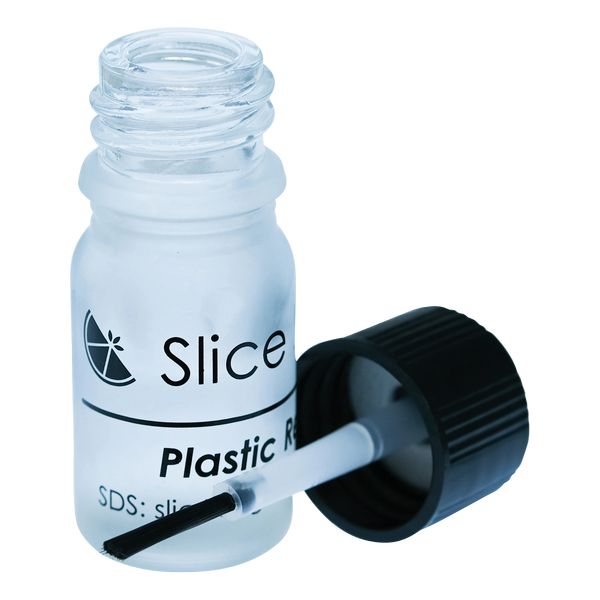
I bumped into a 3D print accessory I’d never heard of, and think it’s a pretty good idea.
The accessory is “Plastic Repellent Paint”, distributed by Slice Engineering. They are a reseller of unusual components for 3D printing since 2017, and their product line consists of a few exotic hot ends, replacement parts, accessories and nozzles.
One of their products is Plastic Repellent Paint, and while I haven’t tried this yet, I believe it could be a tremendous way to avoid major damage on desktop 3D printers.
The problem being addressed here is a certain type of 3D printer failure, in which a large amount of material is deposited on the hot end.
3D Printer Hot End Blobs
Every 3D printer operator, at least for filament machines, has likely encountered this problem. It usually starts with poor bed adhesion, which eventually causes the print to become loose during printing. The loose print is dragged around the print surface, as the printer merrily continues its duty, having no knowledge of the impending failure.
Sometimes the loose print presses against the hot end in such a way to block the flow of hot thermoplastic. This is the opposite of the “spaghetti”-style failure, where you end up with a pile of loose filament strands. Instead you get a growing blob of solid material attached to the hot end.
In extreme cases, which, unfortunately I’ve had several times, the blob grows significantly and slowly encases major portions of the hot end. Sometimes the geometry of the blob is just right to yank off wire connections or snap air ducts.
But most of the time the blob will simply encase the hot end, with flowing thermoplastic seeping into every crevice. Then, when the print “completes”, the device shuts down the heating and the blob solidifies into an unmovable mass.
Novices will typically abandon all efforts at 3D printing upon seeing the hot end catastrophe, but more experienced operators will try to heat up the hot end once again and painstakingly pull off the plastic with needle nose pliers.
If you’re lucky the mass will pull off in a big hunk. But more often it doesn’t, particularly when it’s heated. You will usually end up disassembling the hot end and picking off all the stray plastic bits. After some time you’ll reassemble the hot end and just possibly the machine will resume operations.
But sometimes not. The blob can very easily damage some of the delicate parts of the hot end. At the very least your machine will be down until repaired, and at the worst it will be a write off.
Plastic Repellent Paint
Enter Plastic Repellent Paint. This is a small 3cc bottle of a specialized mix that repels common thermoplastics. The idea here is to paint the hot end components — when they’re cool, of course. When set this surface coating will prevent bonding of thermoplastic to the painted components.
This could make recoveries from “blob situations” a lot easier, as the material would easily pull off. It may also be possible that the stray plastic bits may simply be shaken or brushed off, but I’ll have to give this material a try to find out.
On second thought, maybe I don’t want to try this experiment, as I really don’t want to risk blobbing my hot ends.
According to Slice Engineering:
“Plastic Repellent Paint is a revolutionary, water-based, PTFE nanosuspension that repels plastic from the outside of your nozzle and hot block. Which is awesome, because it prevents that annoying plastic buildup that causes print failures! Plastic Repellent Paint can be applied in seconds using the vial’s brush top, forming a dry, transparent coating that endures print temperatures up to 290°C. Keep your nozzle clean with some high-tech space magic, and worry no more.”
Apparently the paint is good up to 290C, which should cover most common 3D printing material temperatures.
I’d avoid raising the temperature of the nozzle beyond that level, however, as the material safety sheet for the paint says:
“The thermal decomposition vapors of fluorinated polymers may cause polymer fume fever with flu-like symptoms in humans, especially when smoking contaminated tobacco.”
Tobacco?
Also, it seems that the paint is quite irritative to the eyes, so they make it quite clear you should be wearing eye protection when applying it.
Nevertheless, I suspect this product can be easily used in a safe manner, and it should offer an additional level of protection for FFF 3D printers, especially those with poor surface adhesion solutions.
It’s available at Slice Engineering for US$15. And yes, the URL does indeed have a “TM” character in it, the first I’ve ever seen.
Via Slice Engineering (Hat tip to Glen)

PTFE is the scientific name for one of the key components of Teflon. At high temperatures it breaks down into a gas that causes mild symptoms in humans but kills birds. There’s some evidence that if the Teflon coating on a pan is damaged those fumes can be released at lower temperatures. Please be careful using this if you have pet birds / note this in the article.